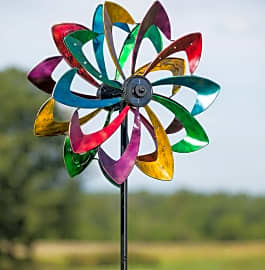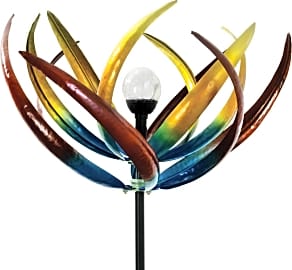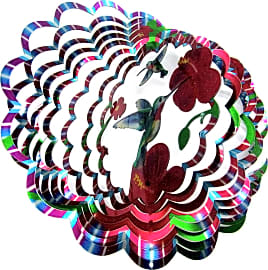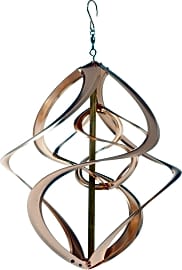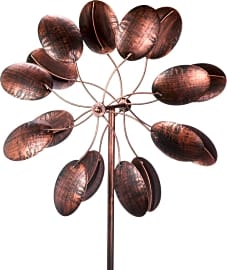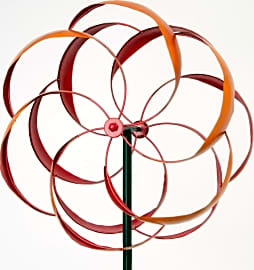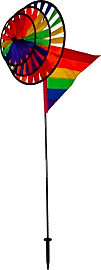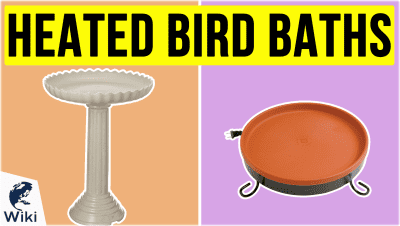The 10 Best Wind Sculptures

This wiki has been updated 39 times since it was first published in August of 2015. Looking for an unusual housewarming, wedding, or anniversary gift? Or perhaps something for that special person in your life who takes great pride in his or her garden? One of these kinetic wind sculptures will be sure to fit the bill. Ranging from elegant to whimsical, they're guaranteed to delight and entertain for years to come. Our selection offers options for every taste and budget. When users buy our independently chosen editorial selections, we may earn commissions to help fund the Wiki.
Editor's Notes
June 11, 2019:
The Stanwood Dancing Willow Leaves retains our top spot, but in a slightly scaled-down version. This piece’s quality craftsmanship enables it to survive the elements for many years, making it worthy of many a collector’s investment. It’ll also hold firmly in the ground, thanks to its four-point pole anchoring design. The pure copper and brass components spin effortlessly, in opposing directions.
Joining the list is the steel and glass Bits and Pieces Tulip, a solar-powered model that puts on a vibrant light show after dark, thanks to an incorporated solar panel that soaks up energy from the Sun all day long. In addition, you’ll appreciate its two tiers of gliding colorful petals.
The VP Home Kinetic 3D Helix is another new addition that’s easy on the wallet and great for those seeking a lightweight, rainbow-colored spinner for the yard. It can be hung in minutes with the included S-shaped swivel hook, so you’ll be able to sit back and enjoy it after just a few minutes of setup.
In this update, we removed the Sunnydaze Gemini, ComfKey Rainbow Spinner, and the nine-foot version of the Stanwood Dancing Willow Leaves due to concerns involving their availability.
Special Honors
Lyman Whittaker Agave Lyman Whittaker wind sculptures can be seen in public places across the U.S., from a basin in Death Valley to an airport in Texas to a train station in Pennsylvania. Select pieces are available for purchase, including the copper and steel, counter-revolving Agave. It features vibrant colors that are sure to be the center of attention, with its inspiration coming from the succulent desert plant bearing its namesake. whitakerstudio.com
Mark White Kinetic Arabesque Made in a Santa Fe, New Mexico studio and shipped around the world, these handcrafted pieces are made of durable copper and high-quality stainless steel that will stand the test of time. The Kinetic Arabesque is a spiraling work that's available in teal and purple, or in a striking silver finish. markwhitefineart.com
What Ancient Cultures Believed About The Wind
This is actually the origin of the term light-hearted; as the feather was seen as the ultimate symbol of the lightness of the spirit.
Throughout history, humans have created stories for the elements and other workings of nature. In early societies, the wind was often attributed to the work of various deities which were held in high regard by their respective cultures.
The Chinese god of the wind is Fei Lian, which translates literally to flying curtain. Fei Lian is personified as a winged dragon with the tail of a deer and the head of a snake. He carries the wind with him in a bag and causes trouble. His rebellious attitude is kept in check by the archer Hou Yi, who shot down 9 competing suns to save Earth.
The Egyptian god Shu was one of the primordial gods, who existed before any others. He was the personification of all things air, including the wind and the breath. Shu means emptiness, which can also be translated as he who rises up. Because he was the personification of air, Shu was considered to have a cooling influence on the world.
To ancient Egyptians, the ostrich feather was both a symbol of Shu and the Goddess Ma'at, who weighed the hearts of the deceased against an ostrich feather during the time of judgement. This is actually the origin of the term light-hearted; as the feather was seen as the ultimate symbol of the lightness of the spirit.
The ancient Greeks had multiple wind gods, one for each of the cardinal directions from which the winds come. Each of the gods are associated with different aspects of the weather and seasons. The god Boreas brought the cold winter air, Zephyrus the west wind, Notos the late summer storms and south winds, and Eurus the east wind.
What Causes The Wind?
Ancient cultures attributed the wind to various gods, and many still believe mystical workings create the wind. Using analytical instruments, the western world has created its own story about what causes the wind to blow.
The motion always flows from areas of high pressure to areas of low pressure.
To the scientific mind, the wind is nothing more than thermodynamic changes in atmospheric pressure. Particles within the air are in a constant state of rapid motion. The motion always flows from areas of high pressure to areas of low pressure. In a high pressure zone, particles experience a high amount of force, and in a low pressure zone, they experience a lower amount force. The high force pushes the particles from the high pressure zone to the lower pressure zone. This movement is felt as wind.
Although we cannot actually see the air moving, we can measure its motion by the force that it applies on objects such as wind sculptures and flags. A flag will point in the opposite direction of the wind, and a wind sculpture will move rapidly as the force of the wind increases. Leaves or swaying branches will also move opposite the direction from which the wind blows.
For the most part, we measure the horizontal aspects of the wind. These are the changes in atmospheric pressure which we feel most. The vertical direction of wind motion is usually small, except in the case of thunderstorm updrafts. It is actually a very important factor for meteorologists to consider, however. As the air rises, it cools to the point of saturation, which creates clouds. The wind moving downwards will cause the evaporation of clouds as it warms; thus creating fair weather.
Will Wind Sculptures Become The Next Wind Turbines?
The wind is energy created from the inexhaustible forces which surround us on a daily basis. This energy releases no pollution into the air or water, and does not contribute to greenhouse gas emissions. Finding ways for everyone to harness this energy may usher in a new wave of sustainability on the planet.
The wind is energy created from the inexhaustible forces which surround us on a daily basis.
Wind turbines may be the cleanest form of energy production possible. In a wind turbine, the force of particles moving in the air spins the turbine's large propellers. This action moves a motor in the center of the turbine, and it is the friction in this motor which generates electricity. In a year, a single turbine may generate power equal to the energy use of over 300 residential homes. This is a lot of power, especially when considering that many turbines can fit on a single square mile of land.
The main concern for those who speak against wind turbines is that they are eyesores. A field of large propellers is not what some people consider picturesque. If natural wind energy is to be harnessed, there must be a way to increase turbine aesthetics while still keeping much of their functionality. Wind sculptures may hold the key.
Creators of wind sculptures must study thermodynamics in much the same way a meteorologist would, in order to predict and shape the most artistic ways to capture the various motions of the wind. Though much of the focus of a wind sculpture is on the artistic form and fluid way it moves, it is easy to see how a balance can be struck between the two to create works of art which also create renewable energy. By simply incorporating lightweight materials into wind sculptures and attaching simple generators to them, creators may be surprised at how much energy they can harness.


